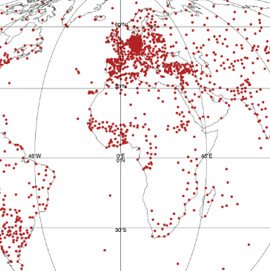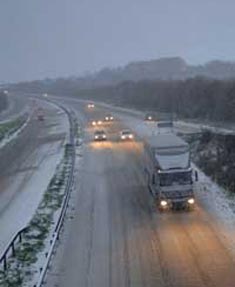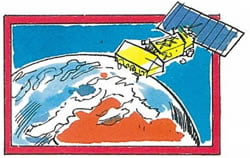Module 1 – the last 2.6 million years
Core Resources
Climate graph, 2.6 million years, without uncertainty


Climate graph, 2.6 million years, without uncertainty


Pathway: Basic Weather
Weather in our Lives – Weather Measurements
Lesson overview: In this lesson we look at the specialist instruments used to measure the weather and how data collected at different locations can be used to create weather maps.
We measure the weather to be able to understand and anticipate its effects on our lives. Gathering large amounts of data across the surface of the Earth using specialist meteorological instruments allows us to monitor atmospheric conditions around the world on a continuous basis. These data allow complex climate system models to create forecasts for many different types of user, from governments, to industry and the general public. There are agreed standards for weather instruments across the world to ensure data are accurate and comparable. With remote logging and transmission of data now possible anywhere on Earth the quantity of weather data available has never been greater. Satellites play an increasingly important role in measuring weather as they obtain information from throughout the depth of the atmosphere. Simpler instruments can also be used to make observations and generate useable data in schools.
Learning objectives:
Key Teaching Resources
Weather Measurements PowerPoint
Weather Measurements Worksheet (complete)
Weather Measurements PowerPoint (easier)
Weather Measurements Worksheet
Weather Measurements Worksheet (easier)
Teacher CPD/ Extended Reading
Read Weather Measurements – More for Teachers
or watch
Alternative or Extension Resources

Pathway: Basic Weather
Weather in our Lives
Lesson overview: In this lesson, we investigate what weather is and how it has an impact on our daily lives – our clothes, food, travel, work and leisure activities.
Weather describes the atmospheric conditions in your location right now and it is impossible to ignore or escape its effects on our everyday lives. Weather affects our lives both directly, for example by determining whether we get sunburnt, and indirectly, for example by affecting the price of our food. It strongly influences our physical environments, both rural and urban. Weather data is provided by the Met Office and various other organisations in the UK and consumed across society to help us accommodate weather in our lives. As our climate changes so does our weather – particularly our extreme weather.
Learning objectives:
Key Teaching Resources
Weather in Our Lives PowerPoint
Weather in Our Lives PowerPoint (Easier)
Teacher CPD/ Extended Reading
Read Weather in Our Lives – More for Teachers
or watch:
Alternative or Extension Resources
Collecting Community Weather Memories
Investigating the correlation between classroom behaviour and weather.
Using weather data to investigate whether sports events can go ahead (Developed by Martin Sutton and previously published in Teaching Geography)
A grid to record the impact of weather on our lives over the course of a week.

This news item from NASA relates to this animation, as does this Nature Communication from October 2020.
Suggested learning activities:
Data and GIS exercise for A Level students
Explore leaf area, evapotranspiration and temperature data using various statistical techniques to explore the relationship between deforestation and weather on this resource on the RGS website.
Activity 1:
Ask students to write a voiceover for the film, demonstrating their understanding of the concepts involved.
Activity 2:
Complete this sentence based on the film:
When rainforests are deforested, places downwind are left with more/ less/ the same amount of rainfall and greater/ less/ the same amount of flood risk.
Activity 3:
Look at www.globalforestwatch.org/map and identify a Tropical region which has experienced deforestation in the last decade.
Look at earth.nullschool.net. What is the prevailing wind direction in that region?
Using www.google.com/maps, write a paragraph explaining how you think the water cycle has been affected by deforestation for a place downwind from the rainforest region you identified.
Activity 4:
Having watched the animation, use https://www.globalforestwatch.org/map , http://earth.nullschool.net and https://www.google.com/maps to write a paragraph explaining how you think the water cycle has been affected by deforestation for a specific place downwind and/ or downriver from a rainforest region.
Activity 5:
Having watched the animation, read these articles from Nature and NASA (noting that this predates the Nature article), NASA (2019), Geography Review (p22 – 25) and Carbon Brief.
Summarise the impact of tropical deforestation on the carbon and water cycles.
More information about the water cycle and climate change and the water cycle and an excellent summary from Cool Geography.


On the BBC news: the research from Swansea University that supports these resources.
1) Show the Film
2) Play the Game
Trees can tell stories about past climates. Scientists can decode the pattern of a tree’s growth rings to learn which years were warm or cool, and which were wet or dry. Scientists combine the ring patterns in living trees with wood from trees that lived long ago, such as the wood found in old logs, wooden furniture, buildings like log cabins, and wooden ships, in order to build a longer historical record of climate than the lifespan of a single tree can provide.
You can decode tree ring data to learn about past climates using the simulation above. Line up tree ring patterns to reveal temperatures in the past. The simulation has two versions. The standard version is the best place to start. The custom version for schools in the United Kingdom was created to go along with a specific curriculum. It has a longer timeline and includes information about some historical events.
The process scientists use to build a climate history timeline has an extra step that, for the sake of simplicity, is not represented in this simulation. When scientists decode long climate records from tree ring patterns, they don’t physically line up the tree core samples next to each other. Instead, they make graphs called skeleton plots for each sample. They combine the skeleton plots from many samples to build a climate history timeline.
Data source for this simulation
The tree ring data in this simulation is from oak trees in southern England. The data, from the UK Oak Project, was collected from living trees, logs in bogs, beams and rafters in old buildings, old wooden furniture, and wall paintings in a farmhouse dating back to 1592. One sample came from the windlass – the wooden crank used to raise and lower a castle’s gate – of the Byward Tower in the Tower of London.
Collect tree ring samples, align the samples to create a 300 year record and see what weather and climate events emerge here.
Alternatively, use the simple paper-strip version from UCAR.
3) Choose the Relevant Teaching Resource
| Resource | Subject | Suggested age range |
| The Difference between Weather and Climate Teachers’ notes and Worksheet. | Geography | 11-14 (KS3) |
| The impact of volcanoes on climate Teachers’ notes and Worksheet. | Geography | 11-14 (KS3) |
| Weather detective – the weather of 1826 Teachers’ notes and Worksheet. | Geography | 11-14 (KS3) |
| Past Climate Change Teachers’ notes and Worksheet. | Geography | 11-14 (KS3) |
| Correlating Tree Rings and Temperature Notes for Teachers and worksheets A , B, C, D and E and/ or spreadsheets A , B, C, D and E | Geography | 11-16 (KS3/4) |
| Solar, Volcanic and Anthropogenic Climate Change Teachers’ notes and Worksheet | Geography | 14-16 (KS4) |
| The Factors Affecting Photosynthesis Teachers’ notes and Worksheet | Biology | 11-14 (KS3) |
Classroom posters: weather and history recorded by a sample of wood from The Tower of London and The Vyne
Guide to Calibration and Natural Climate Proxies (advanced).
Dating the Past Using Stable Isotopes in Tree Rings
Past Summer Rainfall from Oxygen Isotopes in Tree Rings
Unless otherwise stated, all temperature data used in the resources are based on the dataset published in this paper: European summer temperatures since Roman times. More information about the technique can be found in this paper: Oxygen stable isotope ratios from British oak tree-rings provide a strong and consistent record of past changes in summer rainfall.
Symbiosa – an art installation in Paris which linked real-time tree growth with the current environmental conditions.
Resources based on 3D printed sections of the Central England Temperature record.
Climate change negotiations resource for schools.
Past Climate Change from Weather and Climate: a Teachers’ Guide

Outline
Students are to traverse a network in the most efficient manner possible. Consider different information to influence their decisions on the best route to take.
Objectives
By the end of the lesson:
All student will analyse a network and select the most efficient route
Most students will analyse a network and select the most sensible route using additional information
Some students will consider three factors to select the most sensible route at the most appropriate timing
Main Body
Pupils should be given the road network worksheet and information sheet.
Activity 1
The objective for the pupils is to plan a route for the driver of a gritting lorry. Pupils use the information and the map to find the quickest route that allows all roads to be covered at least once. The path should begin and end at the depot (it is not possible to complete the route without overlapping). Pupils should add up the time taken to complete their chosen route and best solutions discussed. Note: some roads are A roads some B.
Activity 2
Pupils are now given the road temperature forecast graphs. The best time to spread grit salt is just before the road temperature freezes (discuss with pupils why this might be). Pupils should use the information given about the freezing time for each road to plot the best route for the gritter to take now.
Extension Activity
When a group have found their optimum route they should then use the timing cards from activity 1 to establish how long their route will take and decide what time the driver should start work/take breaks etc.
Plenary
Discuss how additional information can change the decisions you make.
Lesson resources
Open Road distances standard
Open Road distances advanced
Open Road network map
Open Road temperatures
Web page reproduced with the kind permission of the Met Office.

Outline
The main activity is essentially a simulation of County Council decision making when roads are forecast to freeze. Pupils use temperature forecasts from the Met Office to decide how much salt to spread on the roads and calculate the cost.
Objectives
By the end of the lesson:
All student will use the information from a graph and translate into a response using a key. Most students will evaluate the decisions made in light of additional information.
Starter
Discuss the effects of icy roads, videos of cars skidding from YouTube can be used to illustrate the point.
What are the impacts? Tease out responses of the costs in terms of financial, for example: social costs (costs to NHS/Police), economic costs (lost productivity of workers having time off) and personal costs (damage of car). Make the point that with costs like these it is worth gritting to reduce the impacts.
Pupils (working in pairs) to be given the road gritting planning sheet.
Pupils should use the gritting flowchart (based on a real life plan used by the councils) to decide how much grit should be spread by the council each night following the forecasts given. Pupils should be reminded that weather forecasts are forecasts of what is expected to happen and that conditions might change meaning reality is a little different.
Give the pupils the forecast information sheet.
Go through the first example showing forecast temperature, allowing students to decide what quantity of grit to use and then actual temperature, review this decision.
Using the forecasts for the next few days allow students to assess each day and work out the cost of grit for the week.
Once pupils have successfully assessed the cost of their choice for each day the actual temperature graph for that day can be revealed.
Plenary
Discuss the difference in choices, and the impact that pupils felt they made by their choices.
Lesson resources
Open Road network map
Open Road Temperatures
Open Road gritting flow chart
Open Road gritting planning sheet
Web page reproduced with the kind permission of the Met Office.

Key Stage 3, Maths
Prior learning
A basic knowledge of averages would be useful. The ability to use Excel if computers are used, or the ability to draw line graphs from data.
Objectives
By the end of the lesson:
Students will demonstrate that the temperatures in England are rising
Students will produce a report to justify their findings using graphs and charts where necessary
Look at the graphs. Discuss what the graphs might be showing. If each one is showing the same thing, what could they be? (Use negative axis to help – they show temperatures over a 10 year period)
What time of the year or where in the world might they be showing? Students to discuss:
The Met Office has records of temperature in England. When do you think they started recording temperatures? (1659 is when they recorded a temperature for the country called the Central England Temperature (CET))
Discuss differences between earlier recordings and 1671 then 1699 (reading become more accurate so decimals were used). From the graphs that you have looked at over four different 10 year periods can you tell if temperatures are rising? (No)
Look at the worksheet. Here is a sample of temperatures from one 10 year period. Assign each pair/group to draw the graph for an individual month’s temperatures over the 10 years (x-axis is year, y-axis is temperature).
Once graphs are drawn encourage pupils to think about the questions at the bottom of the page.
Plenary
Discuss results of graphs and questions.
Lesson resources
Central England Temperatures
These monthly mean temperatures are representative of a roughly triangular area of the United Kingdom enclosed by Lancashire, London and Bristol. The monthly series, which begins in 1659, is the longest available instrumental record of temperatures in the world. Live data of Central England Temperatures are available here.
Is temperature rising worksheet.
Web page reproduced with the kind permission of the Met Office.

A series of downloadable lesson plans and teacher’s notes for science GCSE based on using the Gravity field and steady state Ocean Circulation Explorer satellite (GOCE).
Produced by Julie Boyle
 Teachers’ Notes
Teachers’ Notes
 Lesson One
Lesson One
 Lesson Two
Lesson Two
Introduction to GOCE
 Lesson Three
Lesson Three
Freefall
 Lesson Four
Lesson Four
Pendulum
 Lesson Five
Lesson Five
Hooke’s Law
 Lesson Six
Lesson Six
Newton’s Law Pt 1
 Lesson Six
Lesson Six
Newton’s law Pt 2
 Lesson Seven
Lesson Seven
Altimetry
 Lesson Seven
Lesson Seven
Excel Spreadsheet
 Lesson Eight
Lesson Eight
Doppler Effect
 Lesson Nine
Lesson Nine
Bottom Effect
 Lesson Ten
Lesson Ten
Interferometry
 Lesson Eleven
Lesson Eleven
Atmospheric Sounding
 Lesson Twelve
Lesson Twelve
Fluid Dynamics

Key Stage 3, Science
GRAVITY AND SPACE
The solar system is held in place by gravitational attraction and that natural satellites orbit.
By the end of the lesson:
All students will know that:
Most students will know that:
Some students will know that:
Challenge the students to answer the question: “How many things can you think of that we use artificial satellites for?”.
Satellite examples could include weather observations (monitoring weather and climate), TV broadcast, telecommunications, scientific research, environmental monitoring, surveillance (spying!/military intelligence), astronomical (telescopes and measurements from outside our atmosphere), navigational (e.g.GPS)
PDF document containing the starter question
Recap to allow students to remember what a satellite is.
Get students to try making their own satellite using the template supplied.
Meteorology from space
Satellites have been used for weather observations since 1959 when Vanguard 2 was launched.
Types of Satellite
There are two types of satellite orbit; polar orbiting and geostationary. Both are useful for meteorology and other things.
Artificial satellites slideshow.
Get students to use the artificial satellites worksheet to demonstrate they understand the differences between polar orbiting and geostationary satellites.
Artificial satellites worksheet
Web page reproduced with the kind permission of the Met Office.
Have a look at our ‘Watching the Earth‘ resources.
© 2024 Royal Meteorological Society
RMetS is a registered charity No. 208222